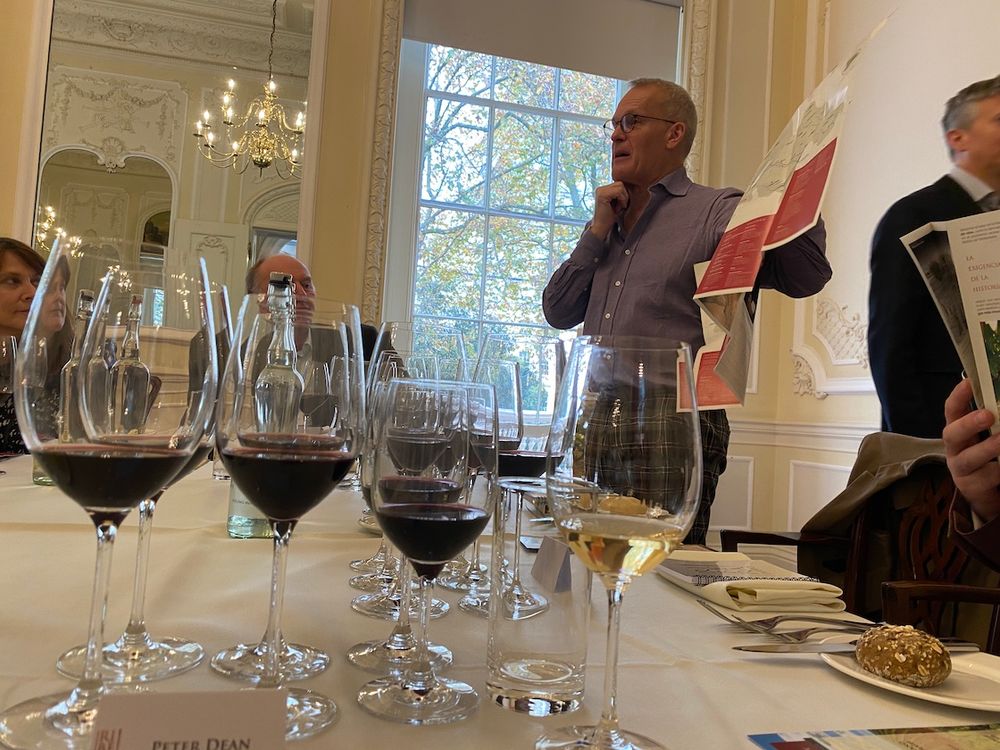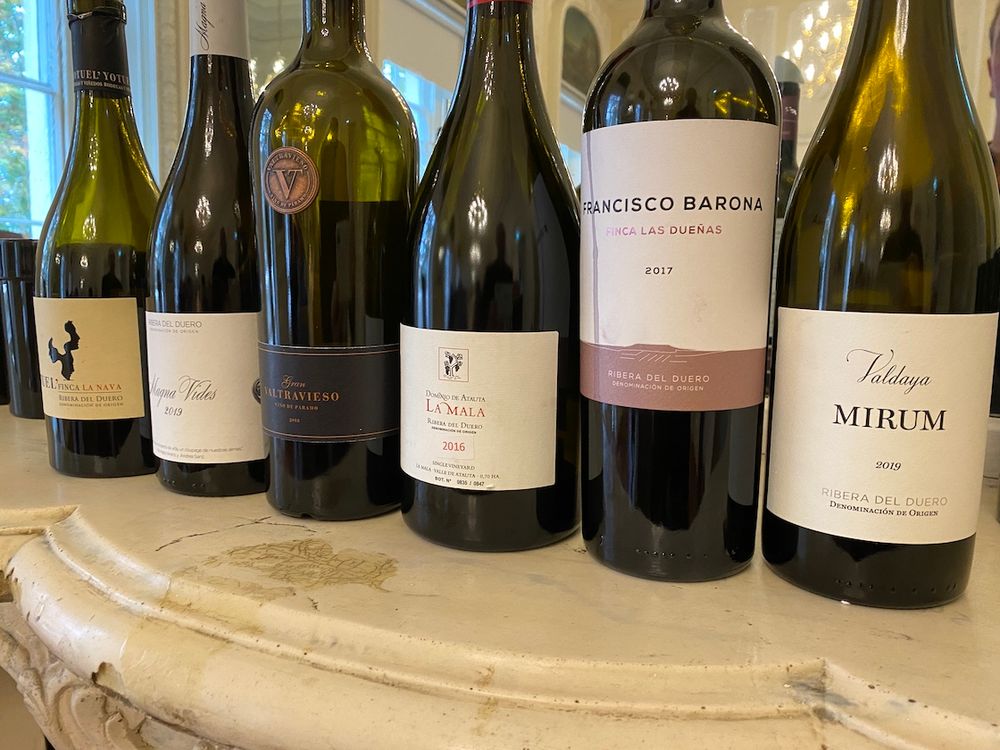“Vineyards that were traditionally marginal (in terms of their viability) are coming into their own, producing cool climate wines,” says Atkin.
Master of Wine Tim Atkin is not a man renowned for casually bandying about superlatives, so when he told us he was “more impressed than ever before” as he introduced his latest Top 100 Ribera del Duero wines, there was a brief hush of contemplation from those gathered at Carlton House Terrace.
Chosen from 537 wines from 149 winemakers, tasted during a visit to the region last September, there is not a single entry in the top 100 with fewer than 94 points, reflecting “the exceptional quality and diversity of the best wines,” rather than score inflation, he assured us, and “underlining the point that the region is one of those to watch in Europe right now,” he said.

Tim Atkin MW, November 16, London
With its 23,360 hectares of vines, extending across Castilla y León from Soria in the east to Valledolid in the west, Ribera del Duero has changed beyond recognition in recent decades. Having first visited in 1991, Atkin revealed that many of the bodegas featured in his Top 100 didn’t even exist back then.
“It’s a hugely dynamic region,” he said, “and I am increasingly fascinated by it because when I first started I simply did not believe I would find what I have since discovered. If you think Ribera is all about power and extraction, then think again, because it absolutely is not.”
“What has also changed since ’91 is climate change. This is an extreme area, at high altitude, up to a thousand metres, so some of the highest vines in Europe, with a limestone bedrock, the theory being it was once under a lake or the sea. Vineyards that were traditionally marginal (in terms of their viability) are coming into their own, producing cool climate wines,” he told us.

Six of the seven wines that Atkin showed over lunch
Atkin singled out the Ribera del Duero DO for praise, assuring us he had been afforded “total freedom” to deliver his report, “which I can assure you is not always the case everywhere.”
“There are three types of vintage in the region: what they call Atlantic for cooler years, there are Mediterranean vintages for hotter ones and then the third category is the ‘frost vintage’ and that is a constant risk,” he said, “so it pays to dress like an onion when you visit because the latest frost I have heard about was in early June.”
Atkin also highlighted what he described as “the general trend towards wines that are village and parcel-specific. Some of the best Riberas are blended across the region – Aalto, Ausàs and Garmón being three top examples – but a growing number reflect individual terroirs.”
After a lunchtime tasting of seven wines, Atkin introduced the full self-pour tasting with a tribute to the generosity of the producers, as he revealed that 87 of his Top 100 wines, which includes five whites, were present for us to sample on the day
A top 10 from the Tim Atkin MW Top 100 wines, tasted, in this case, by Mr Vinosaurus:

Top 100 tasting that followed the lunch
Vega Sicilia Unico Reserva Especial (2022 Release), Non Vintage (imported by Berkmann Wine Cellars), 95% Tempranillo, 5% Cabernet Sauvignon, a blend of three vintages – 2008, 2010 and 2011. Structured, powerful, yet also poised, dappled with notes of cigar box and Christmas spice, the tannins are smooth and seductive. Atkin describes this wine as “perfection”, so it’s little wonder he gives it 100 points.
Vega Sicilia Unico Reserva, 2012 (imported by Berkmann Wine Cellars) From a hot vintage, Atkin gives this 98 points, describing it as “one of Spain’s greatest reds.” 95% Tempranillo, the remainder Cabernet Sauvignon (which makes its presence subtly felt with an appealing graphite note), the nose is elegant, surprisingly dainty and floral, the fruit is ripe, yet not overly so, and this just exudes elegance from start to finish.
Pingus, Flor de Pingus Cosecha 2019 (imported by Corney & Barrow) 100% Tempranillo, Flor is the second wine of Pingus, “what Peter Sisseck calls his La Horra ‘village wine’, which is not to damn it with faint praise in the slightest, given the quality of the liquid,” according to Atkin, in his report. Fresh, youthful and precise, there’s a crunch to the red fruit and the oak influence is well judged, subtle and scrumptious.
Finca Las Dueñas 2017, Francisco Barona (no UK representation), Enjoyed over lunch and revisited in the tasting room, this wine, a blend of majority Tempranillo with Garnacha, Bobal, Albillo Mayor and Jaen, receives 97 points from Atkin, who made Barona his ‘Young Winemaker of the Year’, declaring “Ribera del Duero has a new superstar on its books.” Foraged blackberry, bramble and garrigue combine in a complex, wild-yet-elegant and intricately nuanced wine that has a striking ethereal quality to it.
Garmon 2019, Bodegas Garmon Continental (imported by City Wine Collection), awarded 97 points by Atkin, who makes reference to the combination of fruit from six different villages “blending their characters as an artist might mix a palette of colours.” Perfumed, elegant and polished, with intense cherry depth and incredible concentration.
Hacienda Monasterio 2017 (imported by Berry Bros and Rudd) 80% Tempranillo and 20% Cabernet Sauvignon, from a crop significantly reduced by spring frosts, the wine is perfumed and powdery on the nose, with rose petal, bright red berry fruit and a hint of garrigue. There’s a mineral note, layers of texture and a rich complexity through to the lingering finish. Awarded 96 points by Atkin.
Interpretation 2019, Ausas (imported by Fortnum and Mason), From Xavier Ausàs, the former winemaker at Vega Sicilia, Atkin says Ausas “has established itself in the space of just four vintages as one of the best wines in the region.” A regional blend, it is bright, pure and juicy-fruited, a melange of blueberries, raspberries and redcurrant, beautifully balanced, fresh and modern.
TM 2016 Tr3smano (no UK representation), 100% Tempranillo, awarding it 96 points, Atkin desires this as “a superb modern Ribera.” Mushrooms, forest floor and red berries combine in a bright, delicious, effortlessly elegant wine that has a sort of restrained power, like a caged bull.
Magna Vides 2019 (no UK representation) 90% Tempranillo, the remainder Albillo Mayor, this wine was a highlight of the lunch selection, with its elegant, lifted, cherry blossom nose and delicate, but sustained, red fruit charm. Described by Atkin as “a Ribera red that nods towards Burgundy in style,” he awards it 95 points (which I think is a bit mean, but who am I to argue?)
Callejo, El Lebrero, 2020 (imported by Anthony Byrne Fine Wines) 100% Albillo Mayor, this is one of five whites in Atkin’s Top 100, awarded 94 points. From two high-altitude parcels – La Virgen and El Lebrero – it is fermented in concrete eggs, large oak foudres and stainless steel, with around a third of the blend having some skin contact. A fascinating, fresh, textured wine, perfumed, with pear notes and a lovely salinity.

































